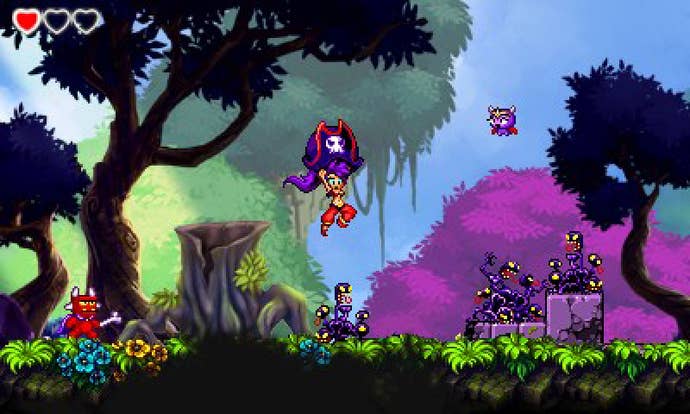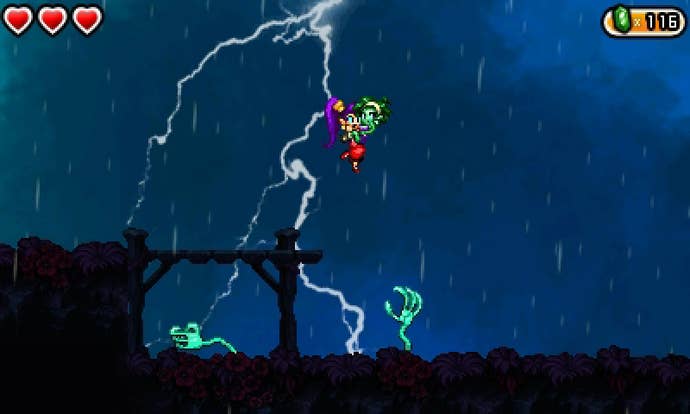Shantae and the Pirate's Curse 3DS Review: Low on Bilge, High on Booty
WayForward's third Shantae finally feels like the game they've been trying to make from the start.
This article first appeared on USgamer, a partner publication of VG247. Some content, such as this article, has been migrated to VG247 for posterity after USgamer's closure - but it has not been edited or further vetted by the VG247 team.
When Shantae debuted back on Game Boy Color in 2002, the world was a very different place. Especially for classic-style 2D action platformers.
Back then, those games seemed a dying breed, having vanished in the revolutionary onslaught of Super Mario 64's radical three-dimensionality. Sprites? Who needs 'em! Side-scrolling? Nowhere near as cool as wandering around in virtual spaces collecting several thousand pointless doodads!
Shantae saw the light of day, but only barely; it appeared on a defunct platform and in such tiny numbers that the cartridge alone now sells for more than 10 times its original price. Still, its very scarcity — not just in terms of quantities shipped but in terms of its alarming lack of contemporaries — made it precious. While Shantae lacked a certain level of balancing one might have hoped for in a game constructed in this current millennium, its ebullient visuals and obvious affection for 8-bit greats made it a breath of fresh air in an era in which that style of game had grown effectively extinct. It wasn't perfect, but by god, it existed, and that was enough to make it remarkable.
These days, though, it's a different story. '90s-style 3D platformers in the Mario style have become rarer than side-scrollers were in 2002. Thanks to the rise of independent publishing, you can't swing a dead cat at a games convention with hitting an angry ASPCA representative playing some kind of retro platformer. Probably one that, like Shantae, owes a tremendous debt to Metroid and Castlevania. So how does a game like Shantae and the Pirate's Curse, the third tale in WayForward's Shantae saga, stand out amidst the likes of Steamworld Dig, Axiom Verge, Chasm, and La-Mulana? Sure, those games owe a small debt to the original Shantae for keeping the home fires burning while the rest of the industry abandoned classic principles in favor of the 3D gold rush, but video games and their fans have a short memory and no particular gratitude for such things.
Fortunately, Pirate's Curse has one big advantage over both the original Shantae and its sequel, Risky's Revenge: It's a much better game. Even larger than Shantae, more polished than Risky's Revenge, it truly feels like a proper realization of the concept. And it's only taken 12 years to get there.
While at first appearance Pirate's Curse might look to be simply a reprise of the previous games in the series, the underpinnings of the action — the mechanics beneath the surface — have changed rather dramatically from what's come before. Shantae began as the world's greatest Wonder Boy/Monster World homage, with its nonlinear game design and emphasis on transformation into different animal forms, but here the adventure plays out more like Metroid. Granted, so do a few dozen other indie games, but Pirate's Curse stands out from the crowd on a few fronts.

For one, it's absolutely gorgeous. WayForward has put together an incredible tribute to the fading art of classic bitmap sprites here, avoiding modern shortcuts like jointed, Flash-style puppet sprites and tracings of pre-rendered objects. WayForward always does solid sprite work, but you can tell this package is in a different class from the standard licensed fare that keeps their lights on. The final stage or two of the game lose a bit of the visual oomph, but overall the game specializes in pampering your visual cortex.
The world of Pirate's Curse bursts with lively detail: Characters pack far more frames of animation than is anywhere near necessary, as do enemies. Incidental details abound, and even backgrounds possess an embarrassment of needless detail. Scuttle Town slowly transforms over the course of the adventure. Bosses fill the screen. When you run past seagulls hanging out in the scenery, they don't just fly away like in other games; they circle in the distance until you give them some space, at which point they alight on their preferred hangout again. Shantae herself has a huge array of skills, and each of them plays out with elaborate animations. This lavish self-indulgence defines the entire game, and Pirate's Curse vies with the best Saturn and Neo Geo had to offer in terms of eye-pleasing sprite work. And the fluid, detailed animation never once interferes with the action.
That's an important fact, because after all beauty is only skin-deep. Shantae has always stood at the vanguard of 2D portable gaming visuals, but the earlier games were either poorly balanced (the original) or else entirely too brief (the sequel). Pirate's Curse manages to rectify both shortcomings at once; it's still not perfect, but there's as much ground to cover here as in both of Shantae's earlier outings combined, and you're rarely left with the sensation that the whole thing could have used a little more play testing.

To be specific, Pirate's Curse takes its strongest design cues not just from Metroid, but from Metroid Fusion. The game world has been broken into several different standalone regions, each bursting with secrets — some simple and obvious, other magnificently obscure and incredibly detailed — and while these don't ultimately interconnect the way Fusion's different sectors did, there's an even greater need to return to previously visited territories once Shantae picks up her new powers. Each world contains at least one complex dungeon designed in a Zelda-like style (in that you're finding keys and tools then returning to previous areas to unlock doors), and several dungeons contain massive sub-dungeons. It's a hefty game for an eShop exclusive, representing at least 10 hours of play to earn the best ending.
Unlike any of the Metroid games, though, Pirate's Curse has a strong adventure element about it in that goals are relayed through dialogue and character interactions... and unlike the contemporary trend in game design, those goals are never overtly spelled out. Sometimes they're so obvious as to be embarrassing, and they're never needlessly obscure, but neither does the game stick a goal marker on the map or pedantically spell out the next step for you. You actually get to puzzle through the clues on your own... a treat as rare these days as Shantae itself was a decade ago.
Those interactions bear mention, too, because they're very interesting to see play out against gaming's current backdrop of feminist discourse and violent anti-feminist activism. As ever, the primary cast of Shantae is all young women. You never quite shake the feeling that this is the case mainly because WayForward's artists wanted to draw lots of cheesecake; I mean, at one point the plot contrives to put all four main characters in Princess Leia metal bikinis, and the tiny girl sprites display ample Paul Robertson-style jiggle animation. On the other hand, this means that with all the dialogue that plays out in the course of the story, Pirate's Curse doesn't so much pass the Bechdel Test as graduate as this year's video game valedictorian.

Really, though, where Pirate's Curse shines is in its level design and Shantae's power-ups. Unlike the animal transformations and dances of previous games, her new skill set works in a more fluid, dynamic fashion. And WayForward's designers didn't simply copy over Metroid's skill set (though this is the first game I can remember to have borrowed Super Metroid's Speed Booster). When you earn a double-jump, it's actually a quadruple jump, and rather than showing up in the first half of the game it comes at the very end. This in turn allows the level design of the final portions of the adventure to contains some absolutely nasty platforming challenges; while the combat can be entirely too easy thanks to the fact that you can carry around more health power-ups than you'll ever need, Pirate's Curse requires more nimble fingers than its predecessors.
Pirate's Curse isn't without its failings. It relies entirely too much on dishing out cheap hits from enemies materializing in untelegraphed locations, and it still carries forward the original game's legacy of giving some enemies entirely too many hit points. Boss fights are hilariously toothless thanks to your ability to carry an inventory crammed full of recovery, buff, and defensive items. And finding certain hidden items degenerates into a process of hitting everything in sight and dashing into walls in hopes of blindly stumbling into a secret path.
On the whole, though, this is great stuff. You don't have to know or have played the previous Shantae titles in order to enjoy the adventure (though they're pretty inexpensive on the 3DS eShop, so you can very conveniently experience the entire trilogy on a single system); it's a solid 2D exploratory action game that stands on its own merits... even amidst the growing throngs of indie metroidvanias. For those who have followed Shantae since her days as the final holdout of 8-bit hardware, though, Pirate's Curse finally allows the series to live up to its legacy.
VisualsA tour-de-force of old-fashioned sprite work. The heavy emphasis on cute girls in skimpy clothes may get you some disapproving frowns when you play in public, though.
SoundAs always, Jake Kaufman's compositions are glorious chiptune bliss.
InterfacePirate's Curse uses every button on the 3DS by the time you're fully powered-up, and to good effect.
Lasting AppealThere's more substance, and more reason to tackle New Game +, than in previous Shantae titles. It's easily big enough to work as a retail release.
ConclusionWith this game, a cult favorite comes into its own. Shantae has always been a passion project for WayForward, but this is the first time the series feels like it properly realizes the developer's ambition for it. A fun, funny, and pleasant substantial Metroid-alike boasting phenomenal old-school visuals and a refreshing sense of optimism, it's both an eShop standout and a great (though by no means final) conclusion to a slow-burning trilogy of games.

